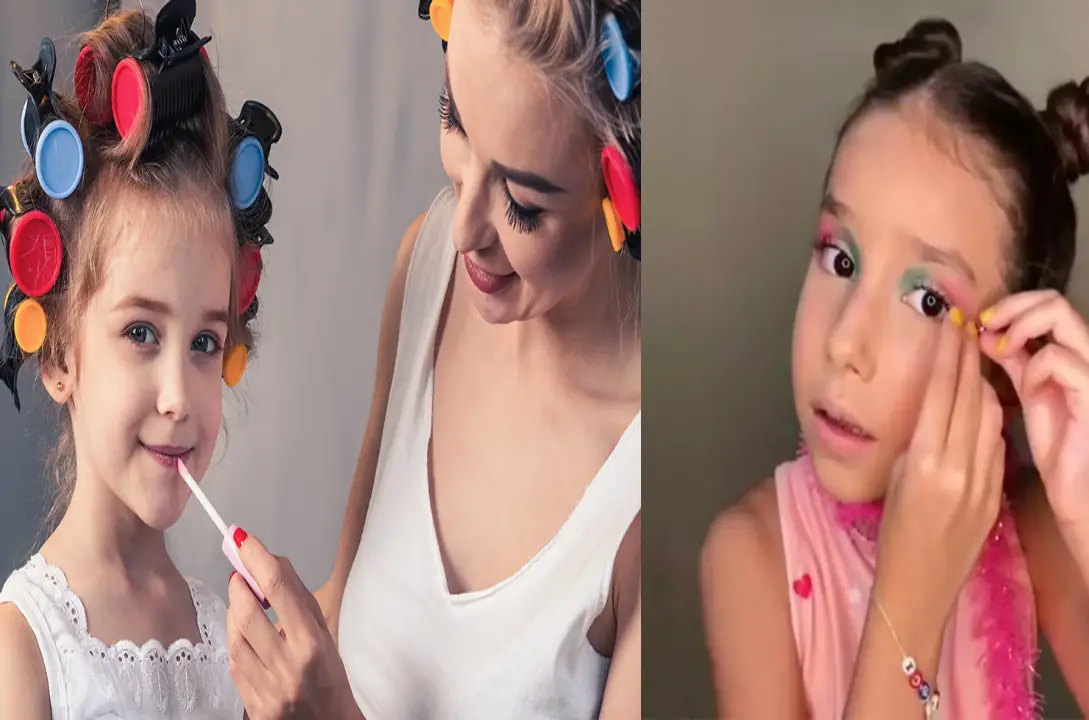Have you ever encountered a dilemma while browsing the cosmetics aisle, wondering whether to let your little one dab on some makeup for a playdate or a special occasion? The question that inevitably pops up is: what is the difference between kid’s makeup and adult makeup?
The primary difference between kids’ and adult makeup is their ingredients and intended use.
Kids’ makeup is specifically designed to be gentle on sensitive skin. It often uses natural and hypoallergenic ingredients and is free from harsh chemicals and fragrances.
The colors are typically brighter and more playful, and the formulas are more accessible to remove. Kids’ makeup is primarily for fun and imaginative play rather than long-term wear.
Adult makeup can contain a broader range of ingredients, including some that may irritate sensitive skin. It is designed to last longer and provide more coverage.
The colors and textures can vary greatly, from subtle to dramatic, and the formulas can be waterproof or long-wearing. Adult makeup is often used for aesthetic and practical purposes, such as concealing blemishes or enhancing features.
As a parent, I completely understand the urge to indulge our children in creative expression through makeup while ensuring their safety and well-being, so I will highlight everything you need to know to make informed choices for your children.
From the ingredients used to the intended purpose, kids’ makeup is formulated with different considerations compared to adult cosmetics. Adults often gravitate towards products that provide a long-lasting effect, vibrant colors, and sophisticated finishes. In contrast, kids’ makeup emphasizes safety, playfulness, and ease of removal.
So, whether you’re a professional makeup artist or an amateur trying to navigate this new terrain, I’m here to guide you through the essential distinctions and considerations.
Ingredients: The Importance of Non-Toxic Formulas
When we discuss the difference between kids’ makeup and adult makeup, one of the first things that comes to mind is the ingredients.
The makeup we use as adults often contains many chemicals, preservatives, and pigments, some of which may not be suitable for sensitive skin, particularly those of children. Kids’ makeup is specifically formulated to be non-toxic and free from harmful ingredients.
Understanding Safe Kids Makeup Ingredients
Kids’ skin is notably more delicate than adult skin, making selecting products with safe, gentle ingredients crucial. Many kids’ makeup brands prioritize non-toxic formulations free from harmful substances such as parabens, phthalates, and synthetic dyes.
These brands use natural pigments and gentle preservatives less likely to irritate a child’s sensitive skin. This is essential when pondering the difference between kids’ and adult makeup.
Common Non-Toxic Ingredients
Some of the safe ingredients you might find in kids’ makeup include:
- Mineral-based pigments provide vibrant colors without synthetic chemicals, ensuring your child can express themselves without compromise.
- Natural oils and butter: Ingredients like coconut oil, shea butter, and jojoba oil help moisturize the skin while providing a smooth application.
- Water-based formulas are more accessible to wash off and less likely to cause irritation or clog pores, aligning with the gentle nature of kids’ makeup.
Brands Leading the Charge
Several brands focus on creating high-quality, safe kids’ makeup. For instance, brands like Little Cosmetics and Snazaroo are known for their gentle formulations that are explicitly designed for children.
They emphasize the importance of non-toxic ingredients and playful packaging, making them favorites among parents looking for safe options.
In contrast, adult makeup brands often utilize a broader range of ingredients to achieve longer-lasting wear and more intense colors, which may not be suitable for young skin.
As a result, the differences in formulation are significant, making it crucial for parents to consider the safety of the products they choose for their children.
When we think about the difference between kids’ makeup and adult makeup, it ultimately comes down to a commitment to safety and gentle care for young skin.
The right choice for your child will always be products that prioritize their health and well-being while allowing for fun and creativity.
Safety: Why Kid’s Makeup is Designed Differently
Regarding makeup, safety is paramount, especially for our little ones. This is another significant area that highlights the difference between kids’ and adult makeup.
Kids’ makeup is crafted to minimize risks associated with cosmetic use, ensuring that the products are as safe as possible for young users.
Special Considerations for Kids
Children’s skin is more porous and sensitive than that of adults, making it essential for kids’ makeup to avoid potentially harmful ingredients.
Adult makeup may include preservatives and chemicals that enhance longevity and pigmentation, but these can lead to allergic reactions or skin irritations in children. As a result, kids’ makeup is formulated with this in mind, employing gentle, hypoallergenic ingredients that reduce the risk of adverse reactions.
Testing and Regulations
Another critical aspect of kids’ makeup is the rigorous testing and regulations these products undergo. Many countries have strict guidelines for cosmetics intended for children, often requiring them to be dermatologically tested to ensure they are safe for sensitive skin.
This level of scrutiny is less common for adult makeup, where formulations can include a broader array of ingredients, some of which might not be suitable for children.
Child-Friendly Formulas
Kids’ makeup is designed to be easily removable, which aligns with the playful nature of how children use these products. Many formulations are water-based and can be washed off with soap and water, eliminating the need for harsh makeup removers that could irritate delicate skin.
This ease of removal is a stark contrast to adult makeup, which is often designed for longevity and requires specific removers to ensure all product is taken off at the end of the day.
Tips for Parents
As a parent, understanding these safety concerns can guide your choices. Look for brands that explicitly market their products as safe for children and check for labels indicating they are free from allergens and irritants. Brands like Bling2o and Mimi & Margo focus on producing safe makeup for children, emphasizing non-toxic ingredients and fun designs that appeal to kids.
Safety is a crucial differentiator when exploring the difference between kids’ makeup and adult makeup. By prioritizing gentle products on the skin, parents can enjoy peace of mind while allowing their kids to explore their creativity.
Durability: The Difference in Wear Time
When we talk about the longevity and durability of makeup, another layer is added to the question: what is the difference between kids’ makeup and adult makeup? While adult makeup is often designed to last throughout the day, kids’ makeup takes a different approach, focusing on the temporary and playful nature of a child’s activities.
The Intent of Kids’ Makeup
Kids’ makeup is primarily intended for short-term wear, aligning with how children typically engage with cosmetics.
Kids often wear makeup for just a few hours, Whether for a fun dress-up session, a themed party, or a playdate. As a result, manufacturers design these products with shorter wear times in mind.
This design philosophy emphasizes the need for makeup that can withstand a day of play without lasting too long, which could lead to skin irritation or difficulty in removal.
Formulation Differences
The formulation of kids’ makeup reflects this focus on short-term wear. Many kid’s makeup products are water-based and contain fewer heavy-duty pigments and chemicals commonly found in adult cosmetics.
For instance, kids’ lip gloss may provide a subtle shine but not the intense pigmentation of adult lipstick. This difference ensures that the makeup is fun, vibrant, and easy to wash off, requiring little more than soap and water.
Adult Makeup Durability
On the other hand, adult makeup products are often formulated for durability. Ingredients like silicone, waxes, and oils are used to enhance the longevity of the product.
Foundations might promise 24-hour wear, while eye shadows are designed to resist fading and creasing throughout the day.
While this durability is desirable for adults who need their makeup to last during busy days, it poses challenges for children. For instance, if a child applies adult makeup and doesn’t easily wash it off, it can lead to frustration and potential skin issues.
Recommendations for Parents
When selecting makeup for your child, consider their activities and the duration of wear. If your little one is gearing up for a special occasion, lightweight, easy-to-remove products like Crayola’s washable makeup are excellent choices. They provide just enough color and fun without worrying about long-lasting formulas that might irritate their skin.
The durability aspect significantly affects the overall experience of using makeup for both kids and adults. Understanding these differences in wear time helps parents make informed choices, ensuring their children can safely enjoy their makeup without the burden of long-lasting products inappropriate for young skin.
Packaging: Kid-Friendly vs. Adult-Oriented Designs
Another vital distinction that emerges when exploring the difference between kids’ makeup and adult makeup is the packaging. While it may seem minor, the design and presentation of makeup products play a significant role in their appeal and usability, especially for children.
Kid-Friendly Designs
Kids’ makeup packaging is often vibrant, playful, and designed to capture a child’s imagination. Think bright colors, fun shapes, and cartoon characters. Brands like L.O.L. Surprise! and Bling2o create packaging that is visually engaging for children, encouraging them to explore and play.
This aspect is not just about aesthetics; kid-friendly packaging often features easy-to-open containers and applicators that suit smaller hands, allowing kids to apply makeup independently.
Additionally, many kids’ makeup brands incorporate safety features into their packaging. For instance, some products come with twist-off caps to prevent accidental spills, while others use child-resistant closures to keep the products secure. This attention to safety ensures that children can enjoy makeup play without the risk of spills or accidents.
Adult-Oriented Designs
In contrast, adult makeup packaging tends to focus on sophistication and functionality. High-end brands often prioritize sleek, minimalist designs, using materials like glass and metal to convey luxury and quality.
Adult packaging is designed for practicality and may include features such as pumps, droppers, and mirrors, catering to an adult’s more complex application needs.
Moreover, labeling adult products can be intricate, providing detailed information about ingredients, application techniques, and usage instructions. While this is helpful for informed consumers, it can be overwhelming and less engaging for children who may not understand the jargon.
Usability Considerations
From a usability standpoint, kids’ makeup is designed to be intuitive. For example, products may come with sponge applicators or built-in brushes that are easy for children to use without adult supervision. This encourages creativity and independence, allowing kids to experiment with colors and styles without frustration.
In contrast, adult makeup packaging might require a level of skill and knowledge that children simply don’t possess. For instance, a liquid eyeliner or a bold lipstick might be tricky for a child to apply effectively, potentially leading to messy results.
Conclusion
Understanding the differences in packaging between kids’ makeup and adult makeup adds another layer to the overall distinction between the two categories.
Kids’ makeup is designed to be fun, accessible, and safe, while adult makeup focuses on aesthetics, functionality, and complexity.
As parents, we can appreciate these thoughtful design choices that allow our children to engage with makeup in a way that fosters creativity without compromising safety.



